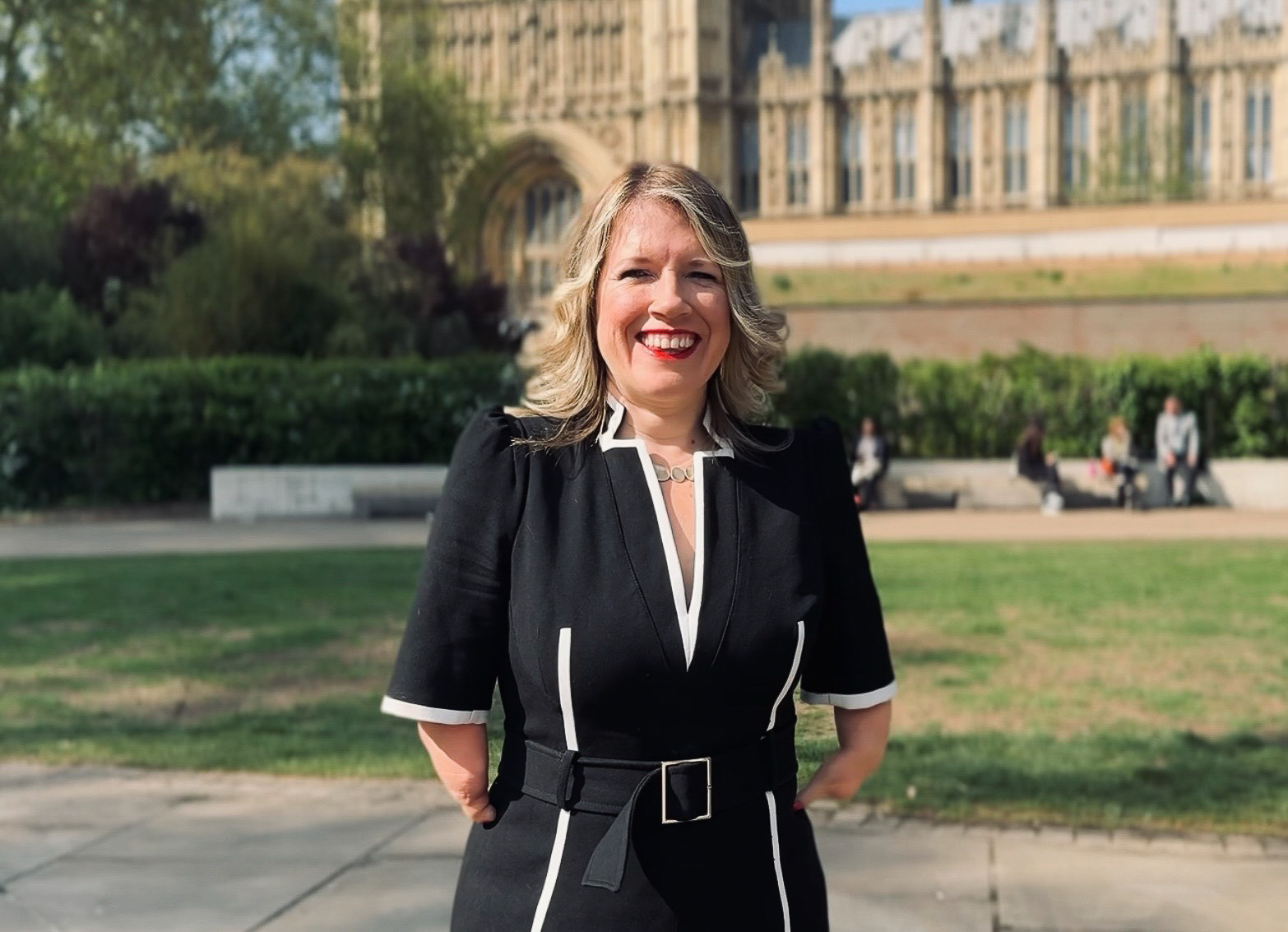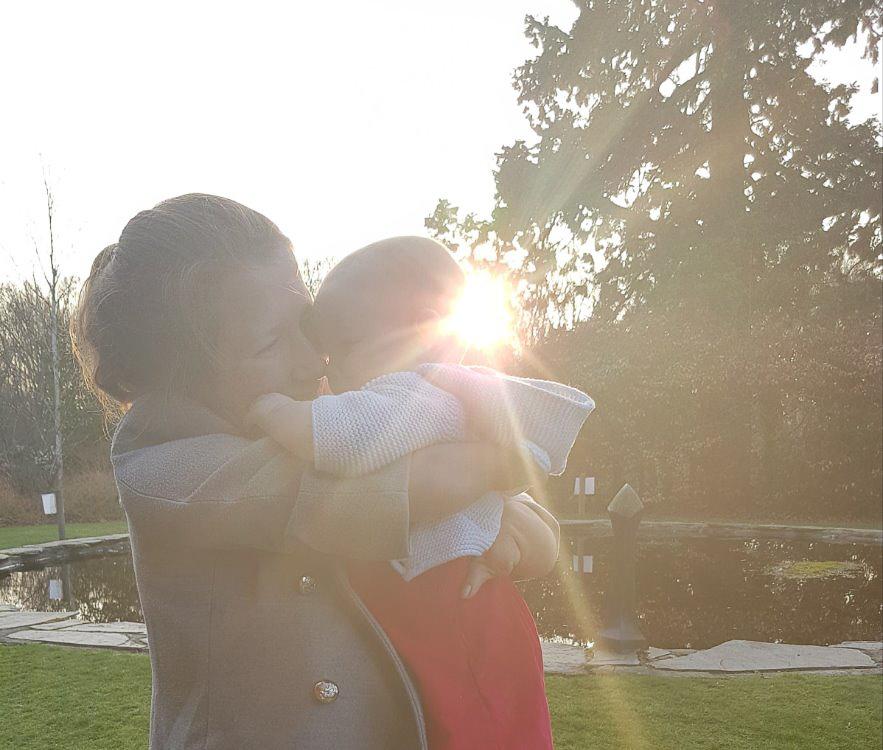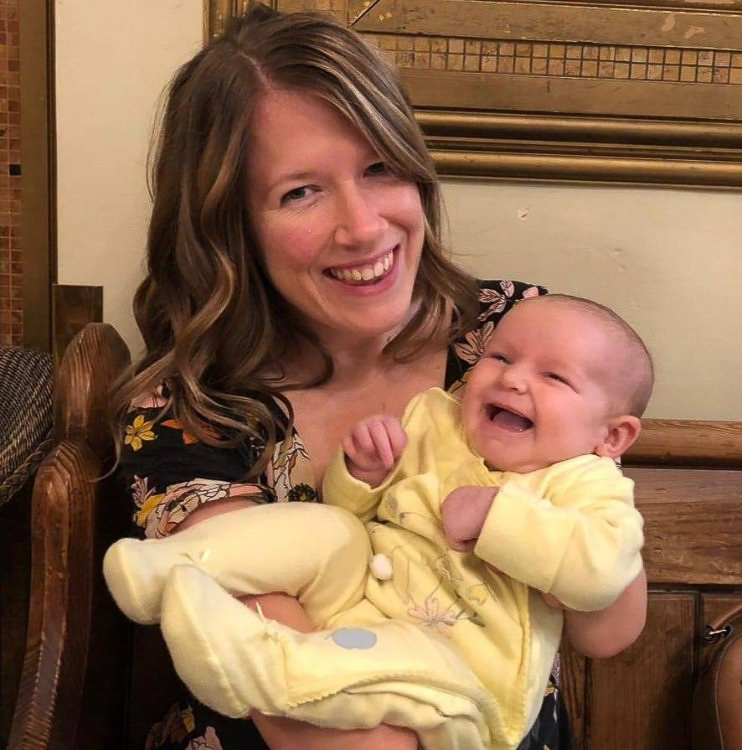
Shared from Within Reach Magazine Summer 2025. Read the latest Within Reach magazine here!
Believed to be one of the first MPs to have congenital upper limb difference, disability campaigner Marie Tidball is sharing her lived experience as a disabled woman, and maternity and pregnancy journey, to shine a light on maternity care – to ensure the next generation of disabled parents can access the support they need and deserve.
“I think there was a kind of anxiety because we don’t really know what caused my own disability, my own limb differences – all four of my limbs are affected.”
Marie’s main concern at first was whether she could get pregnant and carry safely, but until 32 weeks she enjoyed a healthy pregnancy.
However, it wasn’t until Marie’s first midwife appointment that she realised the barriers she would face as a pregnant disabled woman.

“I told the midwife that she might not be able to take my blood,” Marie recalls. “She asked me to repeat myself, and still didn’t understand. By the third or fourth time I’d explained my disability—foreshortened arms with a digit on each hand and an amputation at my ankle—she thought I was saying four shortened arms. She was searching for my missing pair of arms! It was funny in hindsight, but at the time I just thought: how are we going to get through this if there isn’t even familiarity with basic language around disability?”
In the end Marie needed a consultant and a special ultrasound to find a vein just to take routine pregnancy blood tests.
At 32 weeks Marie developed Obstetric Cholestasis, a liver disorder, which can lead to complication and causes severe itching, for this, she says her care was excellent.
However, it was then that Marie’s midwife tried to refer her to a specialist consultant midwife but that appointment never came.
“I was thinking, how am I going to be able to give birth? I’ve had King’s procedure on my hips when I was a child and other surgeries. How would a natural birth affect my hips if I had to use stirrups or have a forceps delivery?”
I was thinking, how am I going to be able to give birth?
She did see a registrar, and she raised her concerns, but instead of reviewing x-rays, the registrar simply asked, “Can you open your legs.”

“There are literally academic papers written about my hips…but in the end, he just had me like laying on the bed, fully clothed with leggings on, to see how wide I could open my legs.”
It wasn’t the scientific approach Marie expected and then again, Marie’s pregnancy experience was disrupted. The first to contact Marie after that was the genetic counselling service.
“That really upset me because the implication was, do you want to keep this baby? What if this baby’s got the same disability as you? It felt entirely inappropriate.”
Marie didn’t engage with that service and didn’t get a meeting with a consultant midwife until the day before she had her baby, which ended up being an emergency caesarean.
Who knows?
Something that repeatedly occurred to Marie was the lack of a “mental checklist” from her health professionals about elements of her disability and how it might interact with her pregnancy.
“I probably never had an accurate blood pressure reading in the whole of my pregnancy.”
It wasn’t until later, after speaking with Sue Kent of Gardener’s World, that Marie would learn of adaptations that could have been helpful to her.
I probably never had an accurate blood pressure reading in the whole of my pregnancy.
“She [Sue] talked about the work that The Thalidomide Society have done – research on how to accurately take blood pressure for people with limb differences. But none of the professionals that I came into contact with seemed to know this.”
This wasn’t the only physical barrier that Marie faced, “So much stuff in the maternity space is inaccessible, like little clips, little poppers, things that are really challenging for people with limb difference.”
After the birth of her daughter, Marie asked for help from an Occupational Therapist about adaptive slings to help her carry her baby or breastfeed but, “They had no clue about any adaptations.”
Marie also struggled with her post-natal mobility due to a longer recovery from her caesarean.
“I rely on my core muscles loads, and when you have caesarean it slices through those muscles but no one had factored that in. I think often nondisabled professionals, including clinicians, assume that the disabled person themselves has all the answers.”
And it wasn’t just physical barriers that Marie faced.
“It was like being five years old again, going to ballet and not being able to do up my shoes. Suddenly you’re going to these mum’s groups or weigh-ins with the baby and it always took me longer…I became really self-conscious so I’d often take my mum with me, but then it very much felt like I was having to have help to look after my own baby which made me lose a huge amount of confidence.”
I asked Marie whether she thinks being disabled means you lessen your expectations, or expect people not to cater for you because you’re the only one who might need help.
“We’re having to advocate for ourselves all the time and educate professionals who should understand these things better, and that’s just exhausting. Particularly with something you’ve never done before.”
We’re having to advocate for ourselves all the time and educate professionals who should understand these things better, and that’s just exhausting.
“I just thought, we’ll just fumble through and as long as my baby’s healthy, I’ll take the indignity, I’ll take the level of anxiety because I don’t know.”
But it wasn’t until she had time to process it that Marie realised what an issue it had been to consider herself and her “body integrity as a secondary issue”.
“I needed that space and that time to come to terms with it…and get that confidence back.”
The Campaign
Marie began to harness her professional, academic background to turn her negative experiences into a positive and progressive campaign for disabled women.
She began to research the guidance and policies that existed and what, if any, research had been done on disabled mothers’ experience of maternity to find out whether hers had been “unusual or as suspected, indicative of a much bigger problem.”
Bringing together academic colleagues and conducting research papers, by the time she ran for Parliament, Marie had built a “national campaign”, confident that she wasn’t alone in her experience.
Marie’s campaign was born directly from her experience; as a public figure, she felt “duty bound” to use her platform to lead change.
Marie and her team worked closely with Professor Hannah Cooper at the London School of Tropical Medicine who conducted a rapid review of the literature and also discovered, “Exclusionary practices” and a lack of “inclusive maternity care.”
“We now also know, as a result of that research, that disabled mothers are 44% more likely to have a stillbirth than non-disabled mothers.”
“There is no expertise on this anywhere. The best experts are the disabled mothers themselves – so we brought together a group of disabled mothers including Paralympians, and mothers with a wide range of disabilities”, some of which are midwives themselves.
Marie and her team began working closely with the Royal College of Midwives (RCM) and the Royal College of Obstetricians (RCO). After launching their campaign in March, they held a summit in April in Parliament, building on the recommendations of Hannah’s report which states that there needs to be “increased expertise” made up of disabled women, “more research and NICE (The National Institute for Health and Care Excellence) guidelines on disability.
“None of the 30 guidelines on fertility, pregnancy and childbirth focus specifically on disability and when disability is mentioned it’s only in passing.”
But it doesn’t stop there, Marie says there needs to be improved accessible health care facilities and information. The system needs to move past the use of genetic counselling “as a gateway to disabled women getting advice and support” and move towards the social model, and “better understanding by all medical professionals” to ensure we’re developing specialism with key midwives.
Looking ahead!
Marie wants the campaign to help “strengthen maternity care delivery in the UK; to improve access experience to reduce that 44% stillbirth risk” and support vital training.
The team are looking at disability passports for disabled mothers with the help of people like, Sarah Faye, an occupational therapist, and a disabled mother.
“[Passports] have already been developed in relation to mothers with autism and learning disabilities, but we want a more general disability passport.” They would include prompts around aspects of pregnancy, such as adaptive equipment or what a particular disabled woman needs in terms of facilities.
Changing attitudes
“Some of the senior members of the RCM were visibly very shocked hearing some of the women’s stories.”
Marie talked about a Paralympian, and a maternity professional, both of which “hadn’t realised that they were pregnant until they were over 30 weeks.” Marie puts this down to the stigma that surrounds disabled women.
“Their clinicians checked out everything else, but the question was never asked. This was within the last five to ten years. The assumption being that disabled women don’t have sexual relationships.”
These kinds of attitudes spur Marie on.
“We’ve met such phenomenal disabled women and they deserve better.”
Marie wants the next generation, Reach children and young adults growing up today, to know that having healthy relationships and families themselves, if they choose to, is absolutely something for them.
This campaign also supports future dads, as a parent with an upper limb difference there may be “challenges for them, in terms of how they hold the baby and doing up clothes and fastenings and getting in and out of cots and things.”
What can Reach do?
Marie says, “Talk about it! And ask people to share any adaptive technology that they discovered.”
Marie would also like to hear from any Reach members who are “obstetricians, gynaecologists, health visitors, occupational therapists or midwives” too.
“We are really trying to include as many people that have both disabilities themselves but also work in the clinical space, I’d encourage them to get in touch with my office and with the Royal College of Midwives as well. I want our house to be more and more inclusive and have greater disability representation as we go on”.

